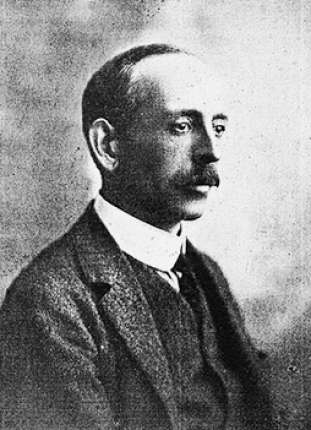Frank Brookhouse Dunkerley
Birth date 1868 at Timperley, Greater Manchester
Death date Monday, 24 September 1951 at Bowdon, Cheshire
Frank Brookhouse Dunkerley was born in Timperley, Cheshire, in 1868, the fourth of seven children of Charles and Mary Dunkerley. His father was a wealthy iron and steel merchant who founded the firm C C Dunkerley & Co Ltd in Manchester in 1845. Shortly after Frank’s birth, the family moved to the fashionable village of Bowdon. They attended the Unitarian church in Altrincham to which they gave substantial financial support.
Following school at Marlborough College, Frank decided on a career in architecture and was articled to Messrs Potts, Pickup and Dixon, the Manchester firm of mill architects. In 1891, he was appointed as a draughtsman for the influential firm of Douglas and Forman in Chester, where he stayed until 1895. He then worked for a short time as assistant to Thomas Roger Smith, the Professor of Architecture at University College, London, who proposed him for membership of the Royal Institute of British Architects. He was elected an associate in 1896 and a fellow in 1907.
In 1897 Frank set up his own practice in Manchester, based at Duchy Chambers on Clarence Street. Business was slow, and commissions mainly came from members of his family or friends, so in 1900 he decided to go into partnership with an older and more established architect, William Angelo Waddington. Angelo and his father William had built up a very successful practice, based in Burnley but covering the whole of the North West, and their speciality was Methodist churches. The new partnership was called Waddington, Son and Dunkerley, despite father William having died in 1891, and they operated from offices in St Ann’s Square, Manchester. They continued to design Methodist churches, but to these they added various commercial buildings and entries for national competitions, where they frequently reached the short list but rarely won. Frank also found time for several private commissions, including houses for himself, wife and family at Hale Barns and for his brother at Mere.
In January 1906, Frank and Angelo decided to terminate the partnership and go their separate ways. Frank had become very involved with various working-class housing schemes, based on principles developed by Octavia Hill, and in 1910 set up the Manchester Housing Company with property in various parts of Manchester. He also took on various public service roles, including Justice of the Peace, chairman of the Board of Governors of Altrincham Grammar School for Boys, and vice-chairman of Altrincham General Hospital Board. In 1914, he was elected President of Manchester Society of Architects, and in the same year invited Isaac Taylor, the son of James Medland Taylor, to share offices with him. Taylor was later joined by William Cecil Young and operated as Taylor and Young. The two practices mainly worked independently, but on occasion joined forces as in the design of a Garden Village at Cheadle for the organisation known as the Manchester and Salford Boys and Girls Refuges and Homes.
Frank Dunkerley died in 1951 aged 83 and was buried at Bowdon parish church. His reputation rests on only a handful of buildings, but it is probably true to say that when he worked independently, he showed a flair for imaginative designs in a broadly Arts and Crafts style. However, because of his inherited wealth, he did not have to work for a living and prompted by a social conscience developed from his liberal non-conformist background, he devoted himself more and more to public duties. Unfortunately, in so doing, he deprived us of more architecture. - Richard Fletcher.
F B DUNKERLEY - Mr Frank Brookhouse Dunkerley, of Bowden, whose death has been reported, had played a prominent part in the public life of Manchester and Cheshire for many years. During his early training as an architect he became familiar with traditional timber construction which influenced his early work when he started his own practice in Manchester. By nature and training a traditionalist, wherever he was commissioned to build his sensitive feeling produced something in keeping with the locality whether in the Lake District, Cheshire, or Sussex. He was president of the Manchester Society of Architects from 1914 to 1916 and had served on numerous local government bodies, being chairman of Bowdon Urban District Council in 1934-36 and a past chairman of Altrincham justices. He was an active member of the CPRE and for eighteen years served on the committees of the District Provident and Welfare Society of Manchester and Salford, becoming president in 1940 on the death of his friend Henry Gaddum. [Manchester Guardian 9 October 1951 page 5]
Death Notice Manchester Guardian Wednesday 26th and Thursday 27th September 1951 Page 8 (Deaths).
Obituary RIBA Journal v58, 1951, page 482
Obituary Manchester Guardian 9 October 1951 page 5
Reference
Who’s Who in Architecture 1926
Biographical File RIBA Library. Microfiche: 60/G5
Information from Richard Fletcher
Address
1901 Mansfield Chambers 17 St Ann’s square, Manchester (Academy Architecture)
1903 Waddington Son & Dunkerley, Mansfield Chambers 17 St Ann’s Square, Manchester
1909 17 St Ann's Square
1910 Frank B Dunkerley 19 Chapel Walk, Manchester (R A Exhibitor)
1911 Frank B Dunkerley 17 St Ann's Square
1926 Frank B Dunkerley 17 St Ann's Square (Who’s Who in Architecture)
1927 Dunkerley Taylor & Young, 19 Chapel Walk, Manchester (R A Exhibitor)
Residence
1898 Hurst Dale Devisdale Road, Dunham Massey, Bowdon (parents’ home)
1903 Greythwaite Hale, Altrincham
1910 Greythwaite Hale, Altrincham (Kelly Cheshire Directory)
1911 Greythwaite Hale, Altrincham
c1923 The Green Bend, Bowden, Cheshire
1951 The Green Bend, Bowden, Cheshire
Buildings and Designs
Partnerships
| Name | Designation | Formed | Dissolved | Location |
|---|---|---|---|---|
| Dunkerley Taylor and Young | Architectural practice | 1922 | 1927 | Manchester |
| Waddington Son and Dunkerley | Architectural practice | 1900 | 1906 | Burnley and Manchester |
